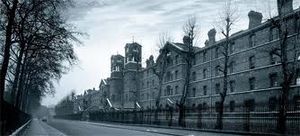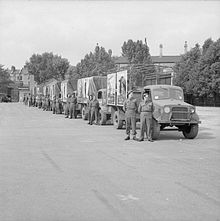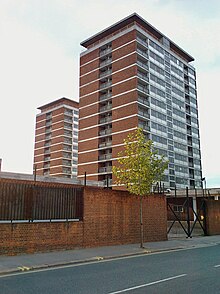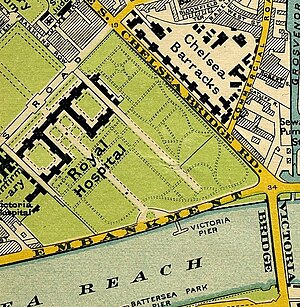Chelsea Barracks
| Chelsea Barracks | |
|---|---|
| London | |
 Chelsea Barracks circa 1870 | |
| Coordinates | 51°29′20″N 00°09′11″W / 51.48889°N 0.15306°W |
| Type | Residential (Former Army Barracks) |
| Site information | |
| Owner | Qatari Diar |
| Site history | |
| Built | 1860–1862 |
| Built for | War Office |
| In use | 1862–2008 |
Chelsea Barracks was a British Army barracks located in the City of Westminster, London, between the districts of Belgravia, Chelsea and Pimlico on Chelsea Bridge Road. The barracks closed in the late 2000s, and the site is currently being redeveloped for residential use by Qatari Diar, a subsidiary of the Qatar Investment Authority (QIA).[1]
History
[edit]


The original barracks, designed by George Morgan to house two battalions of infantry, were completed in 1862.[2] The barracks comprised a long and monotonous brick structure broken by towers in the centre.[3] The original arrangement included a chapel, which survives, and the interior of which includes pictures of King David, the Prophet Joshua, Saint John and Saint James, as well as some panels listing the names of soldiers killed in action.[4] It is now a Grade II listed building,[5] used by the King's Foundation for exhibitions and events.[6]
In the late 1950s, the original buildings, excluding the chapel, were demolished, and in June 1960, construction started on two 13-storey concrete tower-blocks designed by Tripe and Wakeham, which were completed in 1962.[7] The tower blocks were used to accommodate four companies from the Guards Regiments.[8] A nail-bomb attack on the barracks by the Provisional Irish Republican Army on 10 October 1981 killed two civilians and injured up to 50.[9][10]
Development of the site
[edit]
On 6 September 2005 Secretary of State for Defence, John Reid, announced that Chelsea Barracks would be sold.[11] He described it as needing extensive renovations. The site was vacated in 2008 with the troops transferred to the Royal Artillery Barracks at Woolwich. The site was part of the Ministry of Defence's Project MoDEL that saw it and five other sites across London sold off, mainly for housing.[12]
Westminster City Council published its draft planning brief for the Chelsea Barracks site in September 2006. It included a commitment to develop 50% of the site with affordable housing. A Community Forum was established by local residents in April 2006 with the support of Secretary of State for Work and Pensions, John Hutton MP, to campaign for greater transparency in the sale of the barracks site and for the 50% affordable homes commitment to be realised.[13]
2007 sale
[edit]The barracks is in one of London's most expensive residential areas and was originally expected to sell for £250 million.[12] In April 2007 the Ministry of Defence agreed to sell Chelsea Barracks in its 12.8 acres (5.2 ha) site for £959 million to a consortium consisting of Qatari Diar and the CPC Group. On 1 February 2008, the joint venture took possession of the site.[14] Subsequently, CPC's interest in the joint venture company, Project Blue Ltd, was acquired by Qatari Diar, which now owns 100% of the site.[15]
Withdrawn Richard Rogers scheme
[edit]In 2008, a proposed scheme for the barracks site - designed by Rogers Stirk Harbour + Partners - was submitted to Westminster Council. The masterplan was a contemporary design with series of copper, glass and concrete pavilions - with 638 residential units including 50% affordable units.[16]
However, the proposal was criticised by Prince Charles, who preferred a more traditional design for the site.[17][18] The developers Qatari Diar subsequently withdrew the planning application in June 2009.[19] Richard Rogers publicly criticised the Prince's intervention following the withdrawal.[20]
In May 2010, some of the developers made an £81 million claim at the High Court, blaming Prince Charles for the withdrawal of a planning application. The claim was later reduced to £68 million.[21] The High Court ruled that Qatari Diar breached a contract with developers CPC Group when it withdrew Richard Rogers' Chelsea Barracks scheme. The High Court handed a partial victory to property development firm CPC Group, who demanded compensation after plans to redevelop London's Chelsea Barracks were shelved. Christian and Nick Candy blamed an intervention by Prince Charles for giving their partners, Qatari Diar, cold feet.[22] Prince Charles was quoted as saying the Chelsea Barracks project would be "a gigantic experiment with the very soul of our capital city" and went on saying "it should be scrapped in favour of something more old-fashioned". High Court judge, Mr. Justice Vos ruled that Charles' intervention in the design of the project was immediately recognized and raised serious political issues that needed to be dealt with at the highest level, inferring that Charles had intervened unlawfully.[23]
New masterplan
[edit]A new masterplan - designed by Squire and Partners - was approved by Westminster Council in 2011.[24] The site will be built over multiple phases over several years. The scheme will have 448 residential units including 123 affordable units (27%), as well as a new leisure centre, NHS medical centre, community centre and local shops.[25]
In May 2014, Westminster Council granted detailed planning consent for the first phase of the scheme, consisting of 68 apartments across three eight-storey blocks and includes five new garden squares.[26] Construction on this first phase began in 2015.[27] Residents began to move into the development in October 2019.[28]
References
[edit]- ^ "Chelsea Barracks | The Most Coveted 12.8 Acres In The World". www.chelseabarracks.com. Retrieved 23 August 2020.
- ^ "Chelsea Barracks chapel will not be listed but will survive". Evening Standard. 26 November 2009. Retrieved 11 September 2016.
- ^ "Military Life in 1900 London: Barracks". Imperial London. Archived from the original on 20 November 2005. Retrieved 21 August 2012.
{{cite web}}: CS1 maint: bot: original URL status unknown (link) - ^ "Listing protects Guards Chapel in £3bn Chelsea Barracks scheme". 30 March 2011. Retrieved 11 September 2016.
- ^ Historic England. "Guards' Chapel at former Chelsea Barracks (1401791)". National Heritage List for England. Retrieved 11 September 2016.
- ^ "THE GARRISON CHAPEL". The King’s Foundation. 2024.
- ^ "Chelsea Barracks, London: the officers' mess at the north-west corner of the site". RIBA. Retrieved 11 September 2016.
- ^ "Barracks sell for record amount". BBC News. 31 January 2008. Retrieved 21 August 2012.
- ^ "'May have hit wrong target' say Guards". 16 October 1981. Retrieved 21 August 2012.
- ^ "London bomb kills one; hurts up to 50". New York Times. 11 October 1981. Retrieved 28 April 2018.
- ^ "Chelsea Barracks to be sold off". BBC News. 6 September 2005. Retrieved 23 August 2020.
- ^ a b "Chelsea Barracks to be sold off". BBC. 6 September 2005. Retrieved 1 April 2014.
- ^ "Chelsea Barracks Community Forum". Retrieved 1 April 2014.
- ^ Judith Heywood (1 February 2008). "Record £959m buys Chelsea Barracks for developers". Times Online. London. Retrieved 2 September 2009.[dead link]
- ^ "Qatari Diar eyes full control of Chelsea Barracks project". Reuters. 10 November 2008.[dead link]
- ^ "Chelsea Barracks - Rogers Stirk Harbour + Partners". Rogers Stirk Harbour + Partners. Archived from the original on 14 November 2016. Retrieved 23 August 2020.
- ^ "Barracks plan insane, says prince". BBC News. 6 October 2010. Retrieved 23 August 2020.
- ^ Angus Laurie and Mariana Leguia (16 August 2009). "The case of Chelsea Barracks – Prince Charles and Richard Rogers". Glass Magazine. Archived from the original on 29 August 2009. Retrieved 1 September 2009.
{{cite web}}: CS1 maint: bot: original URL status unknown (link) - ^ "Developers withdraw barracks plan". BBC News. 12 June 2009. Retrieved 23 August 2020.
- ^ "Richard Rogers: 'Prince Charles single-handedly wrecked my Chelsea project'". the Guardian. 15 June 2009. Retrieved 23 August 2020.
- ^ Prince Charles 'voiced local views' on Chelsea Barracks, BBC News, 29 June 2010
- ^ Candy brothers win Chelsea Barracks case, Building.co.uk, 25 June 2010
- ^ Booth, Robert (25 June 2010). "Prince Charles's role in Chelsea barrack planning row 'unwelcome'". The Guardian. ISSN 0261-3077. Retrieved 28 October 2023.
- ^ "Chelsea Barracks plan approved by Westminster Council". BBC News. 21 June 2011. Retrieved 23 August 2020.
- ^ "Masterplan | Chelsea Barracks Engagement". Chelsea Barracks Partnership. Archived from the original on 3 August 2020. Retrieved 23 August 2020.
- ^ "Chelsea Barracks Development Exhibition" (PDF). Archived from the original (PDF) on 18 September 2016. Retrieved 11 September 2016.
- ^ "After eight years, work begins on £3 billion Chelsea Barracks". Evening Standard. 16 March 2015. Retrieved 23 August 2020.
- ^ "First look: The super-luxe apartments within a former army barracks in Chelsea". CityAM. 6 September 2019. Retrieved 23 August 2020.

